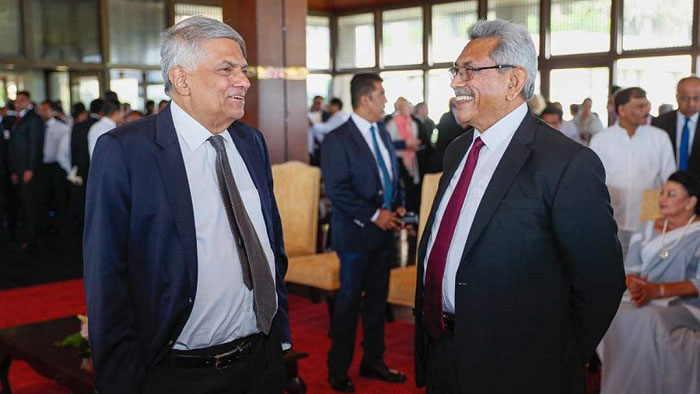Uncertainty prevails over the next government in Sri Lanka as hectic negotiations continued over the weekend and on Monday, July 11.
On July 11, Sri Lankan President Gotabaya Rajapaksa officially informed Prime Minister Ranil Wickremesinghe that he will step down from his position on Wednesday, July 13.
Rajapaksa, who announced his decision to resign on the mentioned date “to ensure a peaceful transition” had earlier indirectly announced his decision to resign on Saturday, July 9 after thousands of angry protestors stormed the presidential palace.
Prime Minister Wickremesinghe, whose private residence was set on fire on the night of July 9, has also announced his resignation to pave way for an all-party-led unity government after meeting several party leaders in an emergency meeting as the mass unrest reached the gates of Rajapaksa’s official residence in the national capital, Colombo.
Visuals from outside PM Ranil Wickremesinghe's house in 5th Lane last night.
Video – #DailyMirror #SriLanka #SriLankaProtests pic.twitter.com/RMPDKydaPk
— Jamila Husain (@Jamz5251) July 10, 2022
By Monday noon, all ministers of the Cabinet had agreed to resign, as announced by Minister of Justice Wijedasa Rajapakshe.
Bandula Gunawardana, the minister of Transport, Highways, and Mass Media, Tourism and Land Minister Harin Fernando, and Labour and Foreign Employment Minister Manusha Nanayakkara, Agriculture Minister Mahinda Amaraweera and Investment Promotion Minister Dhammika Perera were the first to step down after the events of the weekend.
But these resignations are yet to be accepted by the president himself. The ministers will continue in their respective portfolios until the formation of a new government is announced.
As reported by Reuters, leaders of the July 9 protests have said crowds would continue to occupy the residences of the President and Prime Minister in Colombo until they finally quit office.
The process of presidential resignation is governed by Article 40 of the Sri Lankan Constitution and the Presidential Elections (Special Provisions) Act of 1981. According to the line of succession, after the formal resignation of the president is submitted, the prime minister is elected to the position of acting president. However, if the former’s position is also vacant, the speaker of the parliament is temporarily appointed as president.
If Wickremesinghe resigns, Speaker Mahinda Yapa Abeywardena will be sworn in as president. According to the law, the process of electing the new president should be completed within 30 days of the position becoming vacant. The speaker is known to be close to the Rajapaksa family.
At present, the whereabouts of both President Rajapaksa and PM Wickremesinghe are not publicly known. If and when a new government does come to power in the coming weeks, it will be the third government formed in three months.
Before July 9, Wickremesinghe, and his government which only took power two months ago, was in talks with the IMF for a bailout package.
“We are closely monitoring the ongoing developments in Sri Lanka,” Peter Breuer, IMF Senior Mission Chief for Sri Lanka, and Masahiro Nozaki, IMF Mission Chief for Sri Lanka said in a statement following the announcements of the resignations.





